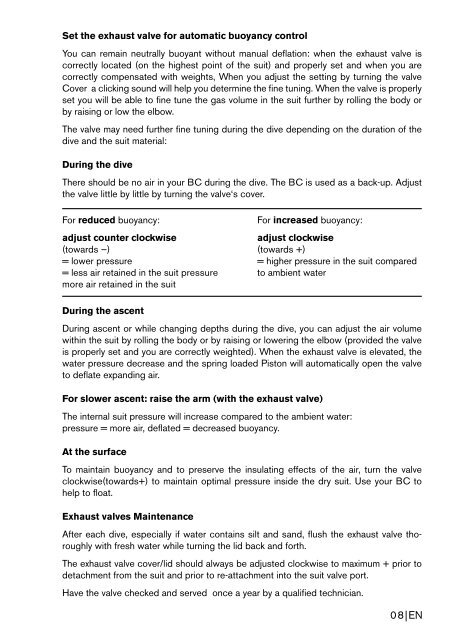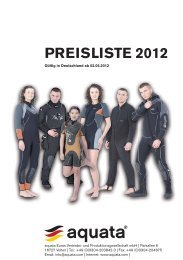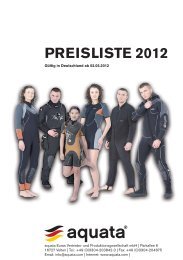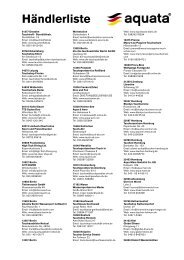GEBRAUCHS- UND PFLEGE- ANWEISUNG FÜR TROCKEN - Aquata
GEBRAUCHS- UND PFLEGE- ANWEISUNG FÜR TROCKEN - Aquata
GEBRAUCHS- UND PFLEGE- ANWEISUNG FÜR TROCKEN - Aquata
Create successful ePaper yourself
Turn your PDF publications into a flip-book with our unique Google optimized e-Paper software.
Set the exhaust valve for automatic buoyancy control<br />
You can remain neutrally buoyant without manual deflation: when the exhaust valve is<br />
correctly located (on the highest point of the suit) and properly set and when you are<br />
correctly compensated with weights, When you adjust the setting by turning the valve<br />
Cover a clicking sound will help you determine the fine tuning. When the valve is properly<br />
set you will be able to fine tune the gas volume in the suit further by rolling the body or<br />
by raising or low the elbow.<br />
The valve may need further fine tuning during the dive depending on the duration of the<br />
dive and the suit material:<br />
During the dive<br />
There should be no air in your BC during the dive. The BC is used as a back-up. Adjust<br />
the valve little by little by turning the valve‘s cover.<br />
For reduced buoyancy:<br />
adjust counter clockwise<br />
(towards —)<br />
= lower pressure<br />
= less air retained in the suit pressure<br />
more air retained in the suit<br />
For increased buoyancy:<br />
adjust clockwise<br />
(towards +)<br />
= higher pressure in the suit compared<br />
to ambient water<br />
During the ascent<br />
During ascent or while changing depths during the dive, you can adjust the air volume<br />
within the suit by rolling the body or by raising or lowering the elbow (provided the valve<br />
is properly set and you are correctly weighted). When the exhaust valve is elevated, the<br />
water pressure decrease and the spring loaded Piston will automatically open the valve<br />
to deflate expanding air.<br />
For slower ascent: raise the arm (with the exhaust valve)<br />
The internal suit pressure will increase compared to the ambient water:<br />
pressure = more air, deflated = decreased buoyancy.<br />
At the surface<br />
To maintain buoyancy and to preserve the insulating effects of the air, turn the valve<br />
clockwise(towards+) to maintain optimal pressure inside the dry suit. Use your BC to<br />
help to float.<br />
Exhaust valves Maintenance<br />
After each dive, especially if water contains silt and sand, flush the exhaust valve thoroughly<br />
with fresh water while turning the lid back and forth.<br />
The exhaust valve cover/lid should always be adjusted clockwise to maximum + prior to<br />
detachment from the suit and prior to re-attachment into the suit valve port.<br />
Have the valve checked and served once a year by a qualified technician.<br />
08|EN







